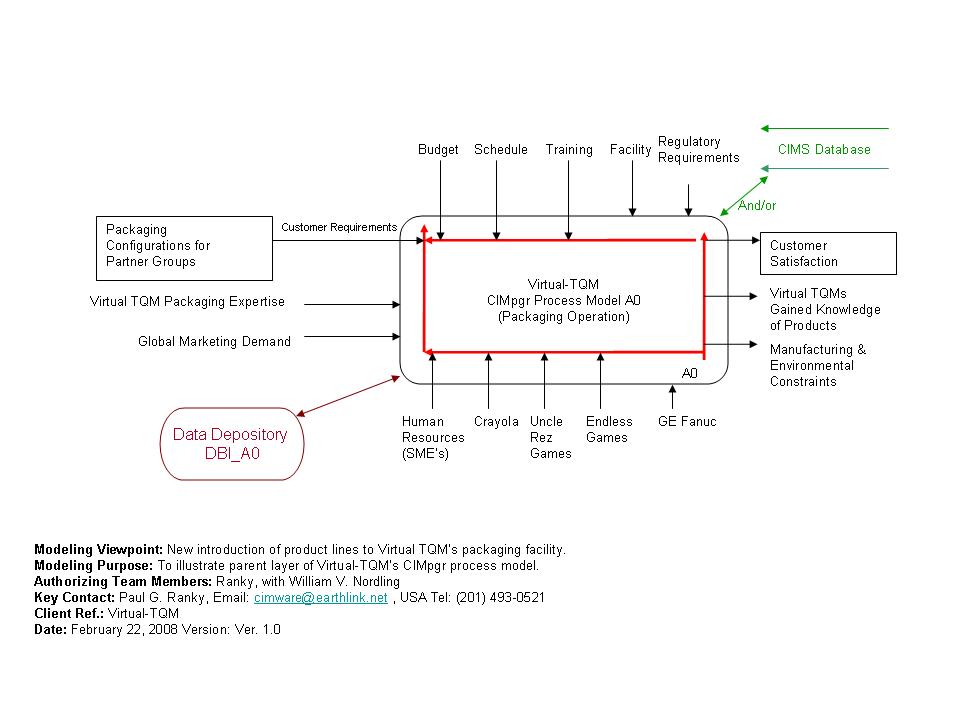|
First Layer of Process Model (A0)
By observation we can see that customer requirments will be driven by the packaging configurations of their
respective product and ranks highest on the priority gauge. To a lesser extent will be in house expertise. The
packaging lines are highly automate and have the latest inspection systems which will ensure that quality product is introduced
to the market. Data will be collected as various prodcuts are introduced and knowledge is gained. This data will
enhance Virtual TQM's understanding of the packaging configurations allowing us to streamline processes and reduce changeover
time if like line set up will be utilized for similar packaging configurations. The ultimate goal with the highest priority
of course is customer/client satisfaction.

Second Layer of Process Model (A1, A2, A3, A4)

Third Layer of Process Model (A3.1, A3.2)

CASE VIDEO FILE
ANALYSIS:
As part of this exercise, two full length
video files were viewed to determine how each company approaches their respective quality assessment. The following contains a
summary of each companies approach to the quality assessments.
Bentley Quality:
Bentley
specializes in automobiles with an high degree of quality and craftsmanship built into there designs. Bentley’s goal, or the “Essence of Bentley” is to deliver a car that portrays style &
design, power & performance and a high degree of cache & sex appeal. These
attributes aren’t necessarily needed for the car to operate correctly yet is incorporated into the design base on customer
feedback and wants. The company maintains a customer base by designing cars that
are extremely pricey due to the quality that is built into them. Most purchasers
of a Bentley are selfmade and purchase the car as a means to flaunt their financial status and success. Bentley acknowledges this and therefore designs there automobiles with customer satisfaction
in mind. Bentley uses materials that the purchaser associates with a quality product and the construction shows a high
degree of craftsmanship. They utilize materials such as wood, leather and metal
to accomplish this. They construct their automobiles with extreme detail and ensure that each automobile is pieced
together with tight tolerances. To a purchaser, they want to see this high level
of detail that comes with the high price tag. They incoporate all standard safety features along with more modern conveniences
such as GPS and elaborate sound systems. All this is tied into a classic yet
timeless look and feel. As previously
mentioned Bentley relishes in the detail and level of their craftsmanship and is unmatched in their eyes. Skilled fabricators are trained to perform the assembly of each automobile with each having years
of experience. From the instrumentation panels to the hand stiched seats the
level quality is superb and shows no variability. The tolerances and marriage
of parts ensure that the appearance showcases a quality product. Comfort and control is also a major part
of each of the automobiles. A large wheel
base ensures adequate space is provided to the driver as well as passengers. The
enlarged rear seating also targets the passengers and allows them to enjoy the overall quality of the cars design as well. Bentley is regarded as the upper echelon in the automobile industry and rely
on their customer base to dictate the level of quality built into their product. They
educate and recruit the best up and coming designers. Younger designers from
around the world bring their contemporary influence to interject new and creative ideas, thus enabling the company to keep
up with the latest innovations.
COGNEX-VISION:
Cognex
vision systems are primarily for the inspection of product for defects. This
is an online system that can be used with continuous production lines. The systems
are multifunctional in that can be used for dimensional gauging, defect inspection, robot guidance and identification. The dimensional gauging capabilities of the systems can be used for measuring distances
and/or tolerances with respect to reference points. It can read edges by viewing
contrasting patterns and thus define shapes. Defective parts can be identified
by programming the system prior to inspection with the correct acceptance criteria. The systems can also be used for
robot guidance for variables such as positioning, angle, scale and variation. Products
can be marked with code for identification puroposes. A 2D data matrix code can
yield information such as type of part and date of manufacture. The systems can also generate statistically data
from measurements. The data can be analyzed online and spot trends that can identify potential trends that might result
in an out of control system. The system is internet based allowing for viewing from various locations. While the
product pass by the vision system it takes a static image with scan time being dependant on line speed and complexity of the
item being scanned. The vision system is much more efficient in identifying components that do not meet specifications.
All of the attributes of the Cognex vision system ensure that a quality product is being shipped to the consumer by elminating
the potential for defective product making its way to market.
SUMMARY:
Utilizing
the CIMpgr approach, one can identify the resources needed to see the
product through its lifecycle. By defining the variables associated with the
production of end product, key activities and responsibilities can be identified and monitored towards improvement. The TQM process model will aid in addressing problematic areas that warrant correction.
FURTHER
WORK NEEDED/PROPOSED:
Virtual-TQM will continue to build
upon the foundation of Total Quality Management outlined herein.
REFERENCES:
Enter supporting content here
IE673-852 TOTAL QUALITY MANAGEMENT
|

